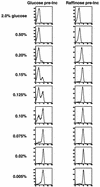Cell signaling can direct either binary or graded transcriptional responses
- PMID: 11406593
- PMCID: PMC150188
- DOI: 10.1093/emboj/20.12.3167
Cell signaling can direct either binary or graded transcriptional responses
Abstract
Transcriptional control is generally thought to operate as a binary switch, a behavior that might explain observations such as monoallelic gene expression, stochastic phenotypic changes and bimodal gene activation kinetics. By measuring the activity of the single-copy GAL1 promoter in single cells, we found that changes in the activities of either the transcriptional activator, Gal4 (by simple recruitment with synthetic ligands), or the transcriptional repressor, Mig1, generated graded (non-binary) changes in gene expression that were proportional to signal intensity. However, in the context of the endogenous glucose-responsive signaling pathway, these transcription factors formed part of a binary transcriptional response. Genetic studies demonstrated that this binary response resulted from regulation of a second repressor, Gal80, whereas regulation of Mig1 by a distinct signaling pathway generated graded changes in GAL1 promoter activity. Surprisingly, isogenetic cells can respond to glucose with either binary or graded changes in gene expression, depending on growth conditions. Our studies demonstrate that a given promoter can adapt either binary or graded behavior, and identify the Mig1 and Gal80 genes as necessary for binary versus graded behavior of the Gal1 promoter.
Figures






Similar articles
-
Multiple regulatory proteins mediate repression and activation by interaction with the yeast Mig1 binding site.Yeast. 1998 Aug;14(11):985-1000. doi: 10.1002/(SICI)1097-0061(199808)14:11<985::AID-YEA294>3.0.CO;2-C. Yeast. 1998. PMID: 9730278
-
How the Rgt1 transcription factor of Saccharomyces cerevisiae is regulated by glucose.Genetics. 2005 Feb;169(2):583-94. doi: 10.1534/genetics.104.034512. Epub 2004 Oct 16. Genetics. 2005. PMID: 15489524 Free PMC article.
-
Regulation of Saccharomyces cerevisiae FET4 by oxygen and iron.J Mol Biol. 2002 Apr 26;318(2):251-60. doi: 10.1016/S0022-2836(02)00093-1. J Mol Biol. 2002. PMID: 12051835
-
Signaling activation and repression of RNA polymerase II transcription in yeast.Bioessays. 1997 Nov;19(11):1001-10. doi: 10.1002/bies.950191110. Bioessays. 1997. PMID: 9394622 Review.
-
Yeast metallothionein gene expression in response to metals and oxidative stress.Methods. 1997 Mar;11(3):289-99. doi: 10.1006/meth.1996.0423. Methods. 1997. PMID: 9073572 Review.
Cited by
-
Stat5 signaling specifies basal versus stress erythropoietic responses through distinct binary and graded dynamic modalities.PLoS Biol. 2012 Aug;10(8):e1001383. doi: 10.1371/journal.pbio.1001383. Epub 2012 Aug 28. PLoS Biol. 2012. PMID: 22969412 Free PMC article.
-
Single-molecule and population probing of chromatin structure using DNA methyltransferases.Methods. 2007 Mar;41(3):320-32. doi: 10.1016/j.ymeth.2006.08.008. Methods. 2007. PMID: 17309843 Free PMC article.
-
The Systems Biology of Single-Cell Aging.iScience. 2018 Sep 28;7:154-169. doi: 10.1016/j.isci.2018.08.023. Epub 2018 Sep 3. iScience. 2018. PMID: 30267677 Free PMC article. Review.
-
Optimization-based synthesis of stochastic biocircuits with statistical specifications.J R Soc Interface. 2018 Jan;15(138):20170709. doi: 10.1098/rsif.2017.0709. J R Soc Interface. 2018. PMID: 29321266 Free PMC article.
-
Frequency-dependent selection: a diversifying force in microbial populations.Mol Syst Biol. 2016 Aug 3;12(8):880. doi: 10.15252/msb.20167133. Mol Syst Biol. 2016. PMID: 27487818 Free PMC article.
References
-
- Axelrod J.D., Reagan,M.S. and Majors,J. (1993) GAL4 disrupts a repressing nucleosome during activation of GAL1 transcription in vivo. Genes Dev., 7, 857–869. - PubMed
-
- Biggar S.R. and Crabtree,G.R. (2000) Chemically regulated transcription factors reveal the persistence of repressor-resistant transcription after disrupting activator function. J. Biol. Chem., 275, 25381–25390. - PubMed
-
- Carey M., Lin,Y.-S., Green,M.R. and Ptashne,M. (1990) A mechanism for synergistic activation of a mammalian gene by GAL4 derivatives. Nature, 345, 361–364. - PubMed
-
- Carlson M. (1999) Glucose repression in yeast. Curr. Opin. Microbiol., 2, 202–207. - PubMed
MeSH terms
Substances
LinkOut - more resources
Full Text Sources
Other Literature Sources
Molecular Biology Databases
Research Materials

